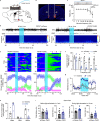Parasubthalamic calretinin neurons modulate wakefulness associated with exploration in male mice
- PMID: 37095092
- PMCID: PMC10126000
- DOI: 10.1038/s41467-023-37797-y
Parasubthalamic calretinin neurons modulate wakefulness associated with exploration in male mice
Abstract
The parasubthalamic nucleus (PSTN) is considered to be involved in motivation, feeding and hunting, all of which are highly depending on wakefulness. However, the roles and underlying neural circuits of the PSTN in wakefulness remain unclear. Neurons expressing calretinin (CR) account for the majority of PSTN neurons. In this study in male mice, fiber photometry recordings showed that the activity of PSTNCR neurons increased at the transitions from non-rapid eye movement (non-REM, NREM) sleep to either wakefulness or REM sleep, as well as exploratory behavior. Chemogenetic and optogenetic experiments demonstrated that PSTNCR neurons were necessary for initiating and/or maintaining arousal associated with exploration. Photoactivation of projections of PSTNCR neurons revealed that they regulated exploration-related wakefulness by innervating the ventral tegmental area. Collectively, our findings indicate that PSTNCR circuitry is essential for the induction and maintenance of the awake state associated with exploration.
© 2023. The Author(s).
Conflict of interest statement
The authors declare no competing interests.
Figures





Similar articles
-
Whole-Brain Monosynaptic Inputs to Parasubthalamic Calretinin Neurons in Mice.Mol Neurobiol. 2025 May 30. doi: 10.1007/s12035-025-05087-x. Online ahead of print. Mol Neurobiol. 2025. PMID: 40445482
-
Ventral pallidal GABAergic neurons control wakefulness associated with motivation through the ventral tegmental pathway.Mol Psychiatry. 2021 Jul;26(7):2912-2928. doi: 10.1038/s41380-020-00906-0. Epub 2020 Oct 14. Mol Psychiatry. 2021. PMID: 33057171 Free PMC article.
-
Cholinergic, Glutamatergic, and GABAergic Neurons of the Pedunculopontine Tegmental Nucleus Have Distinct Effects on Sleep/Wake Behavior in Mice.J Neurosci. 2017 Feb 1;37(5):1352-1366. doi: 10.1523/JNEUROSCI.1405-16.2016. Epub 2016 Dec 30. J Neurosci. 2017. PMID: 28039375 Free PMC article.
-
Neural Circuitry of Wakefulness and Sleep.Neuron. 2017 Feb 22;93(4):747-765. doi: 10.1016/j.neuron.2017.01.014. Neuron. 2017. PMID: 28231463 Free PMC article. Review.
-
A Motor Theory of Sleep-Wake Control: Arousal-Action Circuit.Annu Rev Neurosci. 2019 Jul 8;42:27-46. doi: 10.1146/annurev-neuro-080317-061813. Epub 2019 Jan 30. Annu Rev Neurosci. 2019. PMID: 30699051 Review.
Cited by
-
Whole-Brain Monosynaptic Inputs to Parasubthalamic Calretinin Neurons in Mice.Mol Neurobiol. 2025 May 30. doi: 10.1007/s12035-025-05087-x. Online ahead of print. Mol Neurobiol. 2025. PMID: 40445482
-
Acute or Chronic Exposure to Corticosterone Promotes Wakefulness in Mice.Brain Sci. 2023 Oct 18;13(10):1472. doi: 10.3390/brainsci13101472. Brain Sci. 2023. PMID: 37891839 Free PMC article.
-
Mouse parasubthalamic Crh neurons drive alcohol drinking escalation and behavioral disinhibition.bioRxiv [Preprint]. 2024 Jul 10:2024.07.06.602357. doi: 10.1101/2024.07.06.602357. bioRxiv. 2024. PMID: 39026704 Free PMC article. Preprint.
-
Oxytocin modulates inhibitory balance in the prelimbic cortex to support social memory consolidation during REM sleep.Theranostics. 2025 Feb 18;15(8):3257-3274. doi: 10.7150/thno.109104. eCollection 2025. Theranostics. 2025. PMID: 40093885 Free PMC article.
-
A noncanonical parasubthalamic nucleus-to-extended amygdala circuit converts chronic social stress into anxiety.J Clin Invest. 2025 Aug 15;135(16):e188246. doi: 10.1172/JCI188246. eCollection 2025 Aug 15. J Clin Invest. 2025. PMID: 40829175 Free PMC article.
References
Publication types
MeSH terms
Substances
Associated data
LinkOut - more resources
Full Text Sources
Molecular Biology Databases

